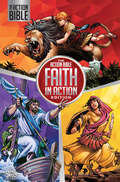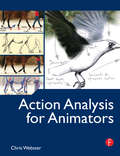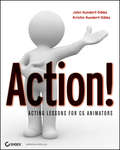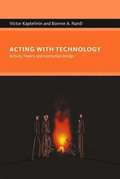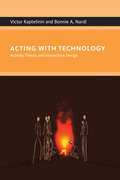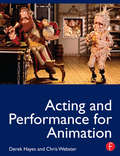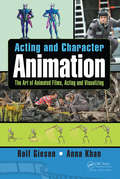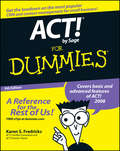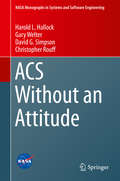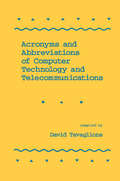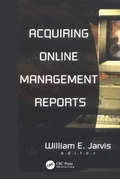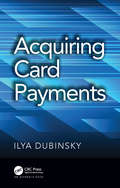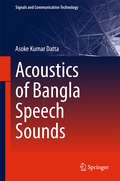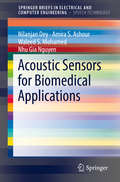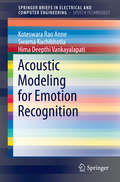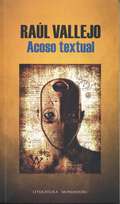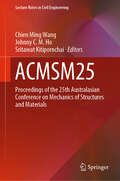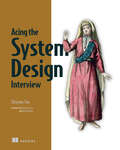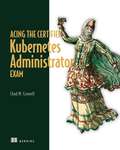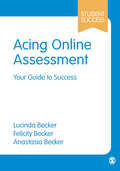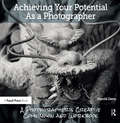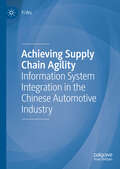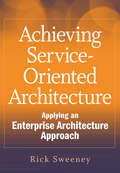- Table View
- List View
The Action Bible: Faith in Action Edition
by Sergio CarielloThis reimagining of the mega-selling Action Bible combines 230 stories of biblical heroes with vibrant comic-book-style illustrations and an immersive online experience. Readers will explore seven dynamic attributes of God&’s story, earn Faith in Action Badges representing those qualities, and discover even more through a discoverable QR code in each story that takes them to a safe online adventure of games, playlists, Bible studies, activities, and a complete devotional designed to increase their time with God. Since its release in 2010, The Action Bible has received widespread acclaim for its high-energy, engaging graphics and over 230 spiritually-transformative Bible stories. Introducing the Faith in Action program that reinvents the bestselling, comic-book-style Bible with a systematic approach to experiencing the Word of God for the next generation. In addition to an interior redesign refresh, this exciting edition includes: The Faith in Action system which gives young readers an easy-to-navigate and engaging experience for exploring the Bible through themes that connect directly to their felt needs. A Faith in Action Badge for each story that corresponds with one of seven biblical attributes: courage, faith, hope, love, service, trust, and wisdom. Discoverable QR codes in every story take readers to a safe online experience to explore even more content: videos, games, a digital Scripture index, prayers, Bible facts, devotions, playlists, reading plans, interactive maps, Bible study sessions, and more. A reading challenge chart spurs young readers on to earn a Faith in Action Title. With all the intrigue of a graphic novel and all the truth of God&’s Word, The Action Bible: Faith in Action Edition satisfies the curious minds and adventurous hearts of today&’s young learners, guiding them to connect more deeply with God&’s Word, develop a richer relationship with their Savior, and grow in their compassion for the world around them.
Action Analysis for Animators
by Chris WebsterAction Analysis is one of the fundamental princples of animation that underpins all types of animation: 2d, 3d, computer animation, stop motion, etc. This is a fundamental skill that all animators need to create polished, believable animation. An example of Action Analysis would be Shrek's swagger in the film, Shrek. The animators clearly understood (through action analysis) the type of walk achieved by a large and heavy individual (the real) and then applied their observations to the animated character of an ogre (the fantastic). It is action analysis that enabled the animation team to visually translate a real life situation into an ogre's walk, achieving such fantastic results.Key animation skills are demonstrated with in-depth illustrations, photographs and live action footage filmed with high speed cameras. Detailed Case Studies, practical assignments and industry interviews ground action analysis methodology with real life examples. Action Analysis for Animators is a essential guide for students, amateurs and professionals.
Action!
by Kristin Kundert-Gibbs John Kundert-GibbsIn order to bring a character to life, it is beneficial for animators to have a solid understanding of acting principles, and this book examines the important skills behind the artistry of creating animated characters. With a particular emphasis on a character's motions and movement, this unique resource covers the basic elements of acting for CG animation and then progresses to more advanced topics such as internal intent and motivation.Note: CD-ROM/DVD and other supplementary materials are not included as part of eBook file.
Acting with Technology: Activity Theory and Interaction Design
by Victor Kaptelinin Bonnie A. NardiActivity theory holds that the human mind is the product of our interaction with people and artifacts in the context of everyday activity. Acting with Technology makes the case for activity theory as a basis for understanding our relationship with technology. Victor Kaptelinin and Bonnie Nardi describe activity theory's principles, history, relationship to other theoretical approaches, and application to the analysis and design of technologies. The book provides the first systematic entry-level introduction to the major principles of activity theory. It describes the accumulating body of work in interaction design informed by activity theory, drawing on work from an international community of scholars and designers. Kaptelinin and Nardi examine the notion of the object of activity, describe its use in an empirical study, and discuss key debates in the development of activity theory. Finally, they outline current and future issues in activity theory, providing a comparative analysis of the theory and its leading theoretical competitors within interaction design: distributed cognition, actor-network theory, and phenomenologically inspired approaches.
Acting with Technology: Activity Theory and Interaction Design (Acting with Technology)
by Victor Kaptelinin Bonnie A. NardiA systematic presentation of activity theory, its application to interaction design, and an argument for the development of activity theory as a basis for understanding how people interact with technology.Activity theory holds that the human mind is the product of our interaction with people and artifacts in the context of everyday activity. Acting with Technology makes the case for activity theory as a basis for understanding our relationship with technology. Victor Kaptelinin and Bonnie Nardi describe activity theory's principles, history, relationship to other theoretical approaches, and application to the analysis and design of technologies. The book provides the first systematic entry-level introduction to the major principles of activity theory. It describes the accumulating body of work in interaction design informed by activity theory, drawing on work from an international community of scholars and designers. Kaptelinin and Nardi examine the notion of the object of activity, describe its use in an empirical study, and discuss key debates in the development of activity theory. Finally, they outline current and future issues in activity theory, providing a comparative analysis of the theory and its leading theoretical competitors within interaction design: distributed cognition, actor-network theory, and phenomenologically inspired approaches.
Acting and Performance for Animation
by Derek HayesCharacter animation involves more than the principles of animation and the mechanics of motion. Unique, believeable characters that think, feel and captivate your audience are ones that involve emotion, performance, personality, acting and story. Successful animators balance all of these elements within a single character and narrative. With Acting and Performance for Animation, discover how to create dynamic, dramatic performances and believeable character interaction. An invaluable resource for animators, Acting and Performance for Animators is a practical guide to the variety of performance techniques relevant to animators. Develop believable character interactions with chapters detailing the principles of performance, performance types, character emotion and personality, physical and psychological performance, and scene composition. Analyze scripts, sound,acting, action and performance with the practical hints and tips, hands-on assignments and animated examples featured in an extensive guide for animators working in film, TV, games and commercials. Explore different performance techniques based upon the experiences of seasoned animators with case studies featuring John Lasseter, Ray Harryhausen, Nick Park, Joanna Quinn. Expand your own performance techniques with the accompanying DVD which will feature live action reference shorts, production stills, animated examples, and further hands-on assignments.
Acting and Character Animation: The Art of Animated Films, Acting and Visualizing
by Rolf Giesen Anna KhanAnimation has a lot to do with acting. That is, character animation, not the standardized, mechanical process of animation. Acting and animation are highly creative processes. This book is divided into two parts: From film history we learn about the importance of actors and the variety of acting that goes into animation; then, we will turn to the actor's point of view to describe the various techniques involved. Through exhaustive research and interviews with people ranging from the late Ray Harryhausen, Jim Danforth, Joe Letteri, and Bruno Bozzetto, this book will be the primary source for animators and animation actors. Key Features Interviews with industry legends are found throughout this exhaustive work on animation From film history we learn about the importance of actors and the variety of acting that goes into animation, then turn to the actor's point of view to describe the various techniques involved Coverage of acting from Vaudeville to Rotoscoping to Performance Capture Case studies throughout bring the content to life while providing actionable tools and techniques that can be used immediately
ACT! by Sage For Dummies, 9th Edition
by Karen S. FredricksAre you ready to reap the benefits of the bestselling contact relationship manager (CRM) software on the market today? Well, then-get into the act with ACT! 2008 and find out how the latest version of this exciting software enables you to set up a database that's right for you so that you can focus on your business and career growth while also saving time and money. With this fun and friendly guide in hand, you'll discover how ACT! organizes customer information in one place, safely shares customer info between workgroups, and provides you with forecast tools, reports, and a contact database. Whether you're new to the features of ACT! or you are familiar with the basics but have not yet put to use ACT!'s more advanced abilities, this nuts-and-bolts reference has been updated and revised to make sure that you are up to speed on the most efficient way to organize your customer relationships and activities. Author and full-time ACT! Certified Consultant and ACT! Premier Trainer Karen Fredricks walks you through tasks such as: Setting up the contact database Adding multiple contacts to a group and adding contacts to a company Changing contact-level security access Scheduling activities Using the basic ACT! Reports Designing new reports Automating the backup process Integrating with Outlook Creating groups ACT! by Sage For Dummies, 9th Edition also boasts a companion Web site that includes all the updates for the 2008 version of ACT! You'll be amazed by just how quickly you'll be able to set up a database and get it to act for you.
ACS Without an Attitude (NASA Monographs in Systems and Software Engineering)
by Christopher Rouff Harold L. Hallock Gary Welter David G. SimpsonThis book de-emphasizes the formal mathematical description of spacecraft on-board attitude and orbit applications in favor of a more qualitative, concept-oriented presentation of these topics. The information presented in this book was originally given as a set of lectures in 1999 and 2000 instigated by a NASA Flight Software Branch Chief at Goddard Space Flight Center. The Branch Chief later suggested this book. It provides an approachable insight into the area and is not intended as an essential reference work. ACS Without an Attitude is intended for programmers and testers new to the field who are seeking a commonsense understanding of the subject matter they are coding and testing in the hope that they will reduce their risk of introducing or missing the key software bug that causes an abrupt termination in their spacecraft's mission. In addition, the book will provide managers and others working with spacecraft with a basic understanding of this subject.
Acronyms and Abbreviations of Computer Technology and Telecommunications
by David TavaglioneCatalogues approximately 7000 acronyms and abbreviations used in computer technology, telecommunications and related fields. The entries are organized in tabular form to enable readers to locate any specific acronym easily.
Acquiring Online Management Reports
by William E. JarvisSave time and money for your library with these current and easy suggestions!Acquiring Online Management Reports offers state-of-the-art information for acquisitions librarians involved in selecting management reports of all types, from fund accounting to decision support systems to usage tracking. Compiling management reports has always been a responsibility of acquisitions librarians. These days, computerized reporting systems have become powerful tools in managing libraries, but they are useful only when the results are accurate, significant, and relevant. Acquiring Online Management Reports discusses techniques for creating and interpreting reports that will give librarians the information they need in an accessible form. This fact-filled guide explores working with vendors, developing cost-effective collection development methods to suit your library, assessing collection growth, and choosing the best electronic resources to help meet your goals.In Acquiring Online Management Reports, librarians will find practical, instantly usable information on pertinent topics, including: the problems created by inaccurate data vendor discussions of how new report systems are designed and implemented the surprising differences between journals’online and print editions expanding usage of decision support systems interpreting the fluctuations of fund accounting information using computer technology to form library consortia computerizing serials controlAcquiring Online Management Reports offers you an array of proven ideas, options, and examples that will enable your library to keep up with changing technologies and client demands.
Acquiring Card Payments
by Ilya DubinskyThis book delves into the essential concepts and technologies of acquiring systems. It fills the gap left by manuals and standards and provides practical knowledge and insight that allow engineers to navigate systems as well as the massive tomes containing standards and manuals. Dedicated to card acquiring exclusively, the book covers: Payment cards and protocols EMV contact chip and contactless transactions Disputes, arbitration, and compliance Data security standards in the payment card industry Validation algorithms Code tables Basic cryptography Pin block formats and algorithms When necessary the book discusses issuer-side features or standards insomuch as they are required for the sake of completeness. For example, protocols such as EMV 3-D Secure are not covered to the last exhaustive detail. Instead, this book provides an overview, justification, and logic behind each message of the protocol and leaves the task of listing all fields and their formats to the standard document itself. The chapter on EMV contact transactions is comprehensive to fully explain this complex topic in order to provide a basis for understanding EMV contactless transaction. A guide to behind-the-scenes business processes, relevant industry standards, best practices, and cryptographic algorithms, Acquiring Card Payments covers the essentials so readers can master the standards and latest developments of card payment systems and technology
Acoustics of Bangla Speech Sounds (Signals and Communication Technology)
by Asoke Kumar DattaThis book presents the consolidated acoustic data for all phones in Standard Colloquial Bengali (SCB), commonly known as Bangla, a Bengali language used by 350 million people in India, Bangladesh, and the Bengali diaspora. The book analyzes the real speech of selected native speakers of the Bangla dialect to ensure that a proper acoustical database is available for the development of speech technologies. The acoustic data presented consists of averages and their normal spread, represented by the standard deviations of necessary acoustic parameters including e. g. formant information for multiple native speakers of both sexes. The study employs two important speech technologies:(1) text to speech synthesis (TTS) and (2) automatic speech recognition (ASR). The procedures, particularly those related to the use of technologies, are described in sufficient detail to enable researchers to use them to create technical acoustic databases for any other Indian dialect. The book offers a unique resource for scientists and industrial practitioners who are interested in the acoustic analysis and processing of Indian dialects to develop similar dialect databases of their own.
Acoustic Sensors for Biomedical Applications (SpringerBriefs in Speech Technology)
by Nilanjan Dey Amira S. Ashour Waleed S. Mohamed Nhu Gia NguyenIn this book, application-related studies for acoustic biomedical sensors are covered in depth. The book features an array of different biomedical signals, including acoustic biomedical signals as well as the thermal biomedical signals, magnetic biomedical signals, and optical biomedical signals to support healthcare. It employs signal processing approaches, such as filtering, Fourier transform, spectral estimation, and wavelet transform. The book presents applications of acoustic biomedical sensors and bio-signal processing for prediction, detection, and monitoring of some diseases from the phonocardiogram (PCG) signal analysis. Several challenges and future perspectives related to the acoustic sensors applications are highlighted. This book supports the engineers, researchers, designers, and physicians in several interdisciplinary domains that support healthcare.
Acoustic Modeling for Emotion Recognition (SpringerBriefs in Speech Technology)
by Koteswara Rao Anne Swarna Kuchibhotla Hima Deepthi VankayalapatiThis book presents state of art research in speech emotion recognition. Readers are first presented with basic research and applications - gradually more advance information is provided, giving readers comprehensive guidance for classify emotions through speech. Simulated databases are used and results extensively compared, with the features and the algorithms implemented using MATLAB. Various emotion recognition models like Linear Discriminant Analysis (LDA), Regularized Discriminant Analysis (RDA), Support Vector Machines (SVM) and K-Nearest neighbor (KNN) and are explored in detail using prosody and spectral features, and feature fusion techniques.
Acoustic Cues in the Disambiguation of Polysemous Strings (Synthesis Lectures on Speech and Audio Processing)
by Maja GwóźdźThis book provides an analysis of acoustic features of polysemous strings and an implementation of a speech disambiguation program based on the phonetic information. Throughout the book, the term ‘polysemous string’ refers to idioms with plausible literal interpretations, restrictive and non–restrictive relative clauses, and the same expressions used as quotations and appearing in a non–quotational context. The author explains how, typically, context is sufficient to determine the intended meaning. But there is enough evidence in psycholinguistic and phonetic literature to suspect that these superficially identical strings exhibit different acoustic features. In the experiment presented in the book, the participants were asked to read short excerpts containing corresponding elements of polysemous strings placed in the same intonational position. The acoustic analyses of ditropic pairs and subsequent statistical tests revealed that there is almost no difference in the duration, pitch, or intensity in literal and figurative interpretations. However, the analysis of relative clauses and quotations demonstrated that speakers are more likely to use acoustic cues to differentiate between the two possible readings. The book argues that the acoustic analysis of polysemous phrases could be successfully implemented in designing automatic speech recognition systems in order to improve their performance in disambiguating polysemous phrases.Analyzes acoustic features of polysemous strings and an implementation of a speech disambiguation programIncludes evidence that superficially identical strings exhibit different acoustic featuresArgues that acoustic analysis of polysemous phrases can be successfully implemented in automatic speech recognition
Acoso Textual
by Raúl Vallejo¿Una? ¿Un? estudiante universitario explora su identidad inventando múltiples personalidades virtuales e intercambiando correos electrónicos con curiosos personajes, virtuales ellos también, alrededor del mundo. Así, banano@wam.umd.edu en ocasiones se presenta como un romántico en busca del amor, en otras es una posgraduada de ciencias políticas que problematiza las utopías socialistas del siglo xx, o se convierte en un explorador del placer del sexo virtual. Para cada uno de sus interlocutores cibernéticos tiene un género, un interés y una personalidad distintos. Es un ser andrógino como el lenguaje. Ahora, banano@wam.umd.edu debe enfrentarse a sus propias preguntas: ¿Debo matar a las personalidades ficticias para encontrar mi identidad verdadera? ¿Debería convertir mis relaciones virtuales en realidades físicas? ¿Qué valor tiene la palabra virtual? Acoso textual, novela pionera en la literatura hispanoamericana en el uso de correos electrónicos para relaciones epistolares, nos ubica en un espacio virtual en que las personas se construyen a sí mismas con las palabras que van y vienen a través de Internet.
ACMSM25: Proceedings of the 25th Australasian Conference on Mechanics of Structures and Materials (Lecture Notes in Civil Engineering #37)
by Chien Ming Wang Johnny C. M. Ho Sritawat KitipornchaiThis book presents articles from The Australasian Conference on the Mechanics of Structures and Materials (ACMSM25 held in Brisbane, December 2018), celebrating the 50th anniversary of the conference. First held in Sydney in 1967, it is one of the longest running conferences of its kind, taking place every 2–3 years in Australia or New Zealand. Bringing together international experts and leaders to disseminate recent research findings in the fields of structural mechanics, civil engineering and materials, it offers a forum for participants from around the world to review, discuss and present the latest developments in the broad discipline of mechanics and materials in civil engineering.
Acing the System Design Interview
by Zhiyong TanThe system design interview is one of the hardest challenges you&’ll face in the software engineering hiring process. This practical book gives you the insights, the skills, and the hands-on practice you need to ace the toughest system design interview questions and land the job and salary you want.In Acing the System Design Interview you will master a structured and organized approach to present system design ideas like: Scaling applications to support heavy traffic Distributed transactions techniques to ensure data consistency Services for functional partitioning such as API gateway and service mesh Common API paradigms including REST, RPC, and GraphQL Caching strategies, including their tradeoffs Logging, monitoring, and alerting concepts that are critical in any system design Communication skills that demonstrate your engineering maturity Don&’t be daunted by the complex, open-ended nature of system design interviews! In this in-depth guide, author Zhiyong Tan shares what he&’s learned on both sides of the interview table. You&’ll dive deep into the common technical topics that arise during interviews and learn how to apply them to mentally perfect different kinds of systems. Foreword by Anthony Asta, Michael D. Elder. About the technology The system design interview is daunting even for seasoned software engineers. Fortunately, with a little careful prep work you can turn those open-ended questions and whiteboard sessions into your competitive advantage! In this powerful book, Zhiyong Tan reveals practical interview techniques and insights about system design that have earned developers job offers from Amazon, Apple, ByteDance, PayPal, and Uber. About the book Acing the System Design Interview is a masterclass in how to confidently nail your next interview. Following these easy-to-remember techniques, you&’ll learn to quickly assess a question, identify an advantageous approach, and then communicate your ideas clearly to an interviewer. As you work through this book, you&’ll gain not only the skills to successfully interview, but also to do the actual work of great system design. What's inside Insights on scaling, transactions, logging, and more Practice questions for core system design concepts How to demonstrate your engineering maturity Great questions to ask your interviewer About the reader For software engineers, software architects, and engineering managers looking to advance their careers. About the author Zhiyong Tan is a manager at PayPal. He has worked at Uber, Teradata, and at small startups. Over the years, he has been in many system design interviews, on both sides of the table. The technical editor on this book was Mohit Kumar. Table of Contents PART 1 1 A walkthrough of system design concepts 2 A typical system design interview flow 3 Non-functional requirements 4 Scaling databases 5 Distributed transactions 6 Common services for functional partitioning PART 2 7 Design Craigslist 8 Design a rate-limiting service 9 Design a notification/alerting service 10 Design a database batch auditing service 11 Autocomplete/typeahead 12 Design Flickr 13 Design a Content Distribution Network (CDN) 14 Design a text messaging app 15 Design Airbnb 16 Design a news feed 17 Design a dashboard of top 10 products on Amazon by sales volume Appendix A Monoliths vs. microservices Appendix B OAuth 2.0 authorization and OpenID Connect authentication Appendix C C4 Model Appendix D Two-phase commit (2PC)
Acing the Certified Kubernetes Administrator Exam
by Chad CrowellBecoming a Kubernetes administrator is a big accomplishment—and passing the Certified Kubernetes Administrator (CKA) exam can be a big boost to your career! Learn the hands on skills you need to ace the exam with clear teaching and hands-on exercises that match the unique CKA test environment.In Acing the Certified Kubernetes Administrator Exam you&’ll learn how to: Administer an application running on Kubernetes Troubleshoot errors inside a Kubernetes cluster Authenticate users and machines to the Kubernetes API Create persistent storage in Kubernetes Add additional functionality to an existing Kubernetes cluster Acing the Certified Kubernetes Administrator Exam is your fast-track to becoming a Certified Kubernetes Administrator! Your expert exam tutor is Chad Crowell, whose courses have helped thousands of developers to understand Kubernetes and earn the coveted CKA certification. If you&’re familiar with Kubernetes, this book will ensure you&’re ready to pass in just one month of study. If you&’re brand new, this is the perfect primer to get started on your Kubernetes journey. Go hands-on with all the exam objectives, including deploying containerized applications to Kubernetes, accessing an application from an ingress resource, and backup and restore. Plus, essential exam tips and exercises help you work out your mental muscle memory. About the technology The Certified Kubernetes Administrator (CKA) exam proves to your next employer that you can set up and manage Kubernetes clusters. In this rigorous test offered by the Linux Foundation, you&’ll configure and manage production-grade clusters hands-on as a proctor watches. Simply put, if you aren&’t ready, you won&’t pass. About the book Acing the Certified Kubernetes Administrator Exam teaches every skill you need to pass the CKA. You can&’t &“hack&” this exam by learning a few test-taking tricks. Instead, you&’ll master vital techniques like load balancing and networking with carefully designed exercises that you practice using the CKA&’s command-line interface. With this book, you&’ll be confident and ready for exam day. What's inside Administer an application on Kubernetes Troubleshoot errors in a Kubernetes cluster Authenticate users and machines Create persistent storage About the reader For readers who know the basics of containers and Linux admin. No Kubernetes experience required. About the author Chad M. Crowell is the author of dozens of courses on Kubernetes and DevOps with Pluralsight and INE. Chad is also a Microsoft Certified Trainer (MCT). Table of Contents 1 First steps 2 Kubernetes cluster 3 Identity and access management 4 Deploying applications in Kubernetes 5 Running applications in Kubernetes 6 Communication in a Kubernetes cluster 7 Storage in Kubernetes 8 Troubleshooting Kubernetes 9 Taking the test
Acing Online Assessment: Your Guide to Success (Student Success)
by Lucinda Becker Felicity Becker Anastasia BeckerFacing an online assessment? Here’s how to ace it. This straightforward guide helps you translate your existing skills into an online environment. It enables you to transition from understanding familiar, offline assessments to succeeding in formal online assessments by breaking down what you are being asked to do - then shows you how to prepare, where to get help and what to do on the day. From presentations to portfolios, it demonstrates that, once you understand this new way of being assessed, you can make the most of working online to improve your grades and excel in your work. It also: Equips you with strategies to help manage anxieties around online assessment. Highlights the challenges and benefits that are unique to online assessment. Demonstrates how to make the most of feedback to support your development as a self-reflective learner. With each chapter built around key student questions, this guide is perfect for dipping into for any type of online assessment.
Acing Online Assessment: Your Guide to Success (Student Success)
by Lucinda Becker Felicity Becker Anastasia BeckerFacing an online assessment? Here’s how to ace it. This straightforward guide helps you translate your existing skills into an online environment. It enables you to transition from understanding familiar, offline assessments to succeeding in formal online assessments by breaking down what you are being asked to do - then shows you how to prepare, where to get help and what to do on the day. From presentations to portfolios, it demonstrates that, once you understand this new way of being assessed, you can make the most of working online to improve your grades and excel in your work. It also: Equips you with strategies to help manage anxieties around online assessment. Highlights the challenges and benefits that are unique to online assessment. Demonstrates how to make the most of feedback to support your development as a self-reflective learner. With each chapter built around key student questions, this guide is perfect for dipping into for any type of online assessment.
Achieving Your Potential As A Photographer: A Creative Companion and Workbook
by Harold DavisComing from the perspective that true inspiration and great image making are at the core of any high-level photographic endeavour, Achieving Your Potential as a Digital Photographer presents an organized and cohesive plan for kickstarting creativity, and then taking the resulting work into the real world. The ideas presented have been formulated by Harold Davis over many years working as a creative artist and award-wining photographer, and in the celebrated workshops he has developed and led all around the world. These concepts are presented with accompanying exercises so that readers can put them into everyday practice as well as workbook pages bound into the book for note taking and journaling. This book will enrich your photographic practice whether the goal is simply to enrich your photography or to make money from your work.
Achieving Supply Chain Agility: Information System Integration in the Chinese Automotive Industry
by Yi WuThis book identifies factors of information system (IS) integration that influence supply chain agility and illustrates how IS integration can achieve greater supply chain agility. Also considering the consequent operational impacts that arise from IS-enabled supply chain agility, the author presents real-life examples through interviews and surveys to explore how IS integrations affect supply chain agility in the context of the Chinese automotive industry. The ability to swiftly respond to competitive challenges is a key element in industry 4.0 and organisations with agile supply chains are better prepared to respond to uncertainties and changes. This book develops and presents guidelines on the deployment of information system integration in order to achieve efficient agile supply chains.
Achieving Service-Oriented Architecture
by Rick SweeneyA complete, comprehensive methodology and framework for adopting and managing a successful service oriented architecture environment Achieving Service-Oriented Architecture helps to set up an SOA Architecture Practice defining the policies, procedures, and standards that apply not just to IT developers but to the entire corporation as it relates to business applications. Why a new architectural approach is necessary for your business to achieve all the value SOA has to offer Focuses on setting up an enterprise architecture practice for service-oriented architecture Discusses the implementation and governance processes for SOA Defines and describes an overall architectural framework for managing SOA assets at an enterprise architecture level Shows how to set up and run an SOA Enterprise Architecture Practice using the methodology and framework presented Defining how an Architecture Practice can transform itself and your corporation to maximize the benefits of the SOA approach, Achieving Service-Oriented Architecture provides a pragmatic enterprise architecture approach and framework for implementing and managing service oriented architecture from a business organization and business practices perspective. Note: CD-ROM/DVD and other supplementary materials are not included as part of eBook file.
